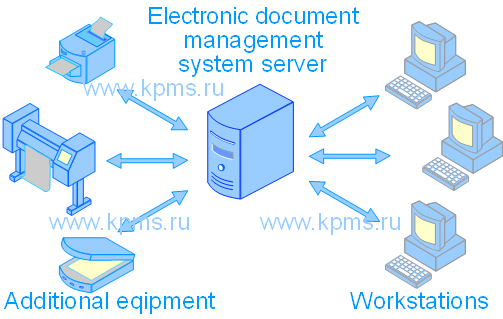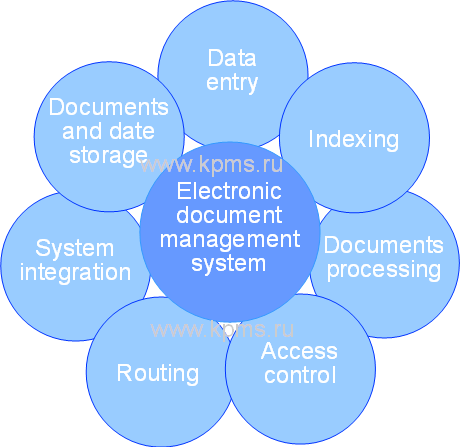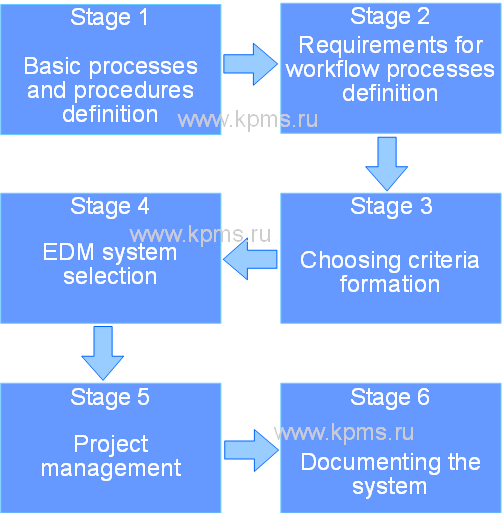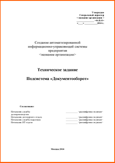The work efficiency largely depends on the efficiency and speed of information management in the conditions of modern business. Reliable storage of information and easy access for those who need it is the key to successful collaboration. Electronic document management systems allow us to solve this task, significantly increasing the efficiency and quality of joint activities of employees.
Electronic Document Management Systems
Electronic Document Management System is an interrelated system of organizational, technical and software for managing various types of documents and information. These systems allow you to manage documents throughout the entire life cycle: from creation to destruction.
The management of documentation, information, various kinds of data and records is one of the complex processes in the work of the organization. Electronic document management systems make it possible to automate this process. Automation of the document flow process helps the organization to significantly increase the speed of work, reduce losses associated with information exchange, and improve the quality of the management system as a whole.
Electronic document management system advantages
Employees of any organization have to spend a lot of time to search and processing the necessary documents and information. As a rule, the volume of such information is only increasing every day. Manual search and processing of documents becomes a source of many problems in the organization. The use of an electronic document management system has a significant impact on the quality of work. These systems give a number of advantages over manual processing.
The main advantages of the electronic document management system include:
- reduction of access time to information. Electronic document flow allows you to avoid paper movement of documents. Any document can be sent by e-mail or through the electronic document management system.
- reducing duplication of documents and information. One copy of the document in the electronic document management system can be available to all authorized users, including users located outside the organization.
- simplifying data access. Electronic document management systems allow you to access the necessary data by searching and exporting data directly from business systems (such as CRM or ERP systems).
- storage optimization of document and data. A single data warehouse reduces the need to store multiple copies of documents. The means of accessing and indexing documents that use electronic document management systems allow users to instantly access the necessary documents and other information.
- business processes automation. Electronic document management systems assume the execution of a given process. Business applications can be automatically updated, new documents can be created, and communication with internal and external users can be established based on actions with documents.
- improving the quality of customer service. Customers can quickly receive answers to their requests due to the quick access to the necessary information.
- improving discipline and quality of work. Electronic document management systems set strict rules and procedures for the work of employees. The system will not allow employees to violate these rules. All documents are stored in the system, have the necessary identification and the order of movement. Employees will not be able to change the document status without performing the specified actions.
- reuse of information. It becomes possible to reuse the data entered into the system due to the electronic processing and storage of information. For example, when you fill in standard forms or reports.
- improving data quality. Many forms and documents are filled in automatically in electronic document management systems, which reduce the risk of errors. It reduces the number of repeated checks of documents and their adjustments.
- improving the safety of documents and information. Employees' access to information and documents can be strictly controlled due to the means of access control. The presence of a single database allows archiving and restoring information in a short period of time.
Electronic document management system structure
The structure of the electronic document management system can be considered from the point of view of the software and hardware complex and from the point of view of the functions performed.
From the point of view of the software and hardware complex, the electronic document management system consists of a set of hardware and software components: servers, workstations, software, network equipment, additional equipment designed to perform specific functions of the system.

The server is designed to perform the necessary operations with documents and information. The server can be either dedicated or virtual, depending on the system provider and the operating technologies used. Also, a database of the document management system can be hosted on the server.
Workstations provide the interaction of users with the document management system. Each workstation has its own set of functions for managing documentation and data.
The software implements the necessary set of actions for document management and it is the basis of an electronic document management system. The software of the electronic document management system, as a rule, includes a functional part, an administrative part and an interface part. The functional part is designed for information management and processing. The administrative part provides the necessary system settings. The interface part performs the presentation of information and data in a form accessible to end users.
Additional equipment is necessary to implement various specific functions of the electronic document management system. Such equipment may include information input and output devices, information encoding and encryption systems, etc.
Network equipment is necessary for the joint work of system users and the interaction of various components of the electronic document management system.
The structure of the electronic document management system from the point of view of the functions performed includes modules that implement the following actions: data entry, indexing, document processing, access control, document routing, system integration, storage.

- the data entry module is necessary for entering the source information into the electronic document management system. This information can appear from various sources: paper documents, scanners, mail, online forms, etc. This module provides data acquisition and initial processing.
- indexing module. It provides registration and systematization of data. The electronic document management system can organize the storage and search of necessary documents in accordance with the needs of users by using this module.
- document processing module. The data must be processed and stored for further work after entering into the system. This module ensures the distribution of information and documents according to the specified rules.
- access control module. This module ensures the distribution of information and documents among users. Each user of the system can work only with the set of documents that he needs.
- the routing module is necessary for organizing work with documents. The rules of movement and processing document are set in this module. Document flow processes must be defined to create document movement routes.
- system integration module. As a rule, electronic document management systems work in interaction with other management systems (for example, CRM, ERP, OLAP systems). The system integration module provides data transfer between such systems.
- document and data storage module. This module implements the functions of a document database. This module provides storage, archiving, restoration, backup of documents.
Electronic document management systems types
Electronic document management systems may differ in the types of used technologies, the degree of integration and the scope of application.
Four types of electronic document management systems can be distinguished depending on the used technologies:
- client-server systems. The main modules of documentation and data management are located on a dedicated server in this type of systems. The client part is an interface for user interaction with the system. The advantage of this system type is their speed and reliability.
- database systems. These systems are usually integrated with databases such as SQL or Oracle. All information is stored in these databases. Independent modules are used to process information. The advantage of such systems is the ability to store a large volume of information.
- web technologies systems. These systems provide work based on remote access to the server. The advantage of this technology is the ability to refuse client applications. Access to the document management system from users' workplaces can be carried out through web browsers.
- "cloud" technologies systems. These systems are similar in nature to systems with web technologies. The only difference is that the hosting provider's server is used as the server of the electronic document management system.
Electronic document management systems can be divided into the following types depending on the degree of integration:
- universal electronic document management systems (EDMS systems). These are independent document management systems that fully designed to automate the documentation management process. As a rule, such systems use client-server technology.
- group work management systems. These systems provide distributed work with documents and data of a users group. Their main purpose is to ensure joint work. Therefore, group work management systems have significantly less functionality than EDMS systems.
- built-in modules as part of management information systems. All ERP systems have such modules. These modules have also limited functionality (in comparison with EDMS systems) and, as a rule, they do not work without the introduction of basic functionality of ERP systems.
The scope of application is another direction in which electronic document management systems can be structured. There are electronic document management systems that are focused on special types of documentation or fields of activity. For example, PDM systems, software development support systems, Help Desk type systems, medical documentation support systems, etc.
Electronic document management system implementation
The implementation of an electronic document management system includes several stages that the organization must perform independently, regardless of the participation of the system supplier. These stages include a set of logically interrelated actions and activities that will allow the organization to evaluate the project as a whole and increase the likelihood of successful completion of the project.
The general scheme of the electronic document management system implementation stages is shown in the figure.

The main stages of the implementation of the electronic document management system include:
Stage 1. Basic processes and procedures definition.
The purpose of this stage is to clearly define the composition of existing document management processes and documentation processing procedures. It is necessary to conduct a detailed analysis of existing processes and procedures to do this.
It is necessary to do during this stage:
- top-level processes define;
- the detailed composition of the processes determine;
- business goals for workflow processes define;
- technical goals for workflow processes define.
Stage 2. Requirements for workflow processes definition.
It is determined at this stage what changes need to be made to the workflow processes so that they work efficiently and can be automated.
It is necessary at this stage:
- to carry out a technological assessment of document management processes;
- define business process requirements;
- prepare process maps "as should be";
- establish measurable process characteristics;
- formulate technical requirements for document management processes and prepare a technical task.
Example of documents:
The process map "Incoming Correspondence Management" represents one of the documentation management subprocesses.
Incoming correspondence management regulates the order of acceptance, verification, registration and management of incoming documentation of the organization. The process map describes in detail the order of actions of employees when working with incoming documentation. The conditions of this process map can be used to develop document routing during the implementation of an organization's electronic document management system.
The document includes 9 pages.
The process map “Outgoing Correspondence Management” represents part of the documentation management process.
Outgoing correspondence management regulates the procedure of employees' actions when preparing and sending documents to external addressees. The process map describes in detail the work of employees in managing outgoing correspondence. The conditions of this process map can be used to develop document routing during the implementation of an organization's electronic document management system.
The document includes 9 pages.
The TS for the “Document Management” subsystem is an example of a Technical task for automating of the document management process. This document is an example of a real Technical task. Document management automation system of an industrial enterprise was selected and implemented based on these TS.
The document includes 17 pages. The document format is Microsoft Word 2002. It is compatible with all versions of MS Word. The document allows editing and making changes.
Stage 3. Criteria for choosing an electronic document management system formation.
It is necessary to formulate a set of criteria for choosing an electronic document management system based on the data of the first and second stages. The criteria for choosing an electronic document management system will determine the scope of further work and the procedure for organizing interaction with the supplier of system.
It is necessary at this stage:
- classify existing documents by type;
- to evaluate the existing forms of documents;
- determine the composition of the data that will be transferred to the electronic form;
- define user interface requirements;
- create a set of criteria for choosing an electronic document management system.
Stage 4. An electronic document management system selection.
This stage allows the organization to determine the main technologies on the basis of which the electronic document management system will work, select the appropriate system and determine the service provider for the implementation of the electronic document management system.
It is necessary at this stage:
- determine the functions composition of the document management system;
- determine the type of document management system that best meets the organization needs;
- form a list of possible suppliers of the electronic document management system;
- select the supplier of the electronic document management system.
Stage 5. Project management for the implementation of an electronic document management system.
It is necessary to develop an implementation plan after selecting the supplier of the electronic document management system. This stage can take quite a long time. Therefore, the planning time will help to significantly reduce the time for the implementation of the system. The plan can be developed with the service provider together.
The project management plan should include the following activities:
- designing the system functionality;
- system implementation;
- testing and evaluation of the system;
- pilot operation of the system;
- refinement and configuration of the system.
Stage 6. Documenting the system.
This stage can be performed in parallel with the previous stage. The purpose of this stage is to create certain organizational rules that will ensure the stable operation of the electronic document management system.
It is necessary at this stage:
- staff training;
- develop procedures and regulations for user interaction;
- develop a manual for working with the system.
Criteria for choosing an electronic document management system
The criteria for choosing an electronic document management system depend on the needs and capabilities of the organization. The detailed composition of the criteria should be determined directly on the basis of business goals and technical goals of the workflow processes.
The organization should use generalized criteria in addition to detailed criteria. They should be related to the types of electronic document management systems and the technologies used.
Such generalized criteria include:
- "maturity" of the electronic document management system. It is necessary to assess the "maturity" level of the selected system. Such assessment will allow you to understand how long the system has been on the market, how many organizations use this system, whether there are system updates. If the system is new and has just entered the market, then there is a high probability of errors in the operation of the system. This can lead to problems during the operation of the electronic document management system.
- accordance with industry standards. Various types of activities have their own standards that directly or indirectly affect the organization's workflow. It is necessary to pay attention to the requirements of these standards and how they are taken into account in the electronic document management system, when choosing a system.
- accordance with goals and critical success factors. It is necessary to take into account the degree of accordance with the goals of the organization when choosing a system. It is important that the system meets the goals and key requirements of the organization as much as possible. If the system does not meet the requirements, then it is necessary to change the choice of the system, but not to change the key requirements and goals. An organization can change part of the requirements for a specific document management system, but only if these requirements are not critical for the organization's processes.
- technical support level. This criterion relates to the choice of the electronic document management system supplier. It is necessary to assess the level of technical support of the system, both during implementation and during operation of the system.
- system scalability. This selection criterion is important from the point of view of extension the organization's activities. It should allow the organization to scale solutions as the amount of work increases and the user base of the system expands.
- availability of system documentation. It may be important for an organization to have access to documentation on administration or changing system settings in addition to user documentation.
- system protection. It is necessary to pay attention to the security measures applied in the system when choosing it. An organization may have its own requirements for data security and privacy policy. The selected system should allow you to configure access to information and documents in accordance with the security policy of the organization.
- system fault tolerance. The downtime of an electronic document management system can be a critical factor for some organizations. It is necessary to pay attention to time that may be requirements for restore the system in the minimum operating configuration when choosing a system.
- cost of ownership. It is necessary to take into account the total cost of ownership of the system when choosing a system: the cost of purchasing licenses, the cost of administration, the cost of system expansion, the cost of technical support and updates, the cost of hardware, etc.
These criteria include the most general aspects of choosing an electronic document management system. It is necessary to involve many departments of the organization to develop a full set of criteria: management, legal service, IT departments, technical specialists, document management specialists, etc.



